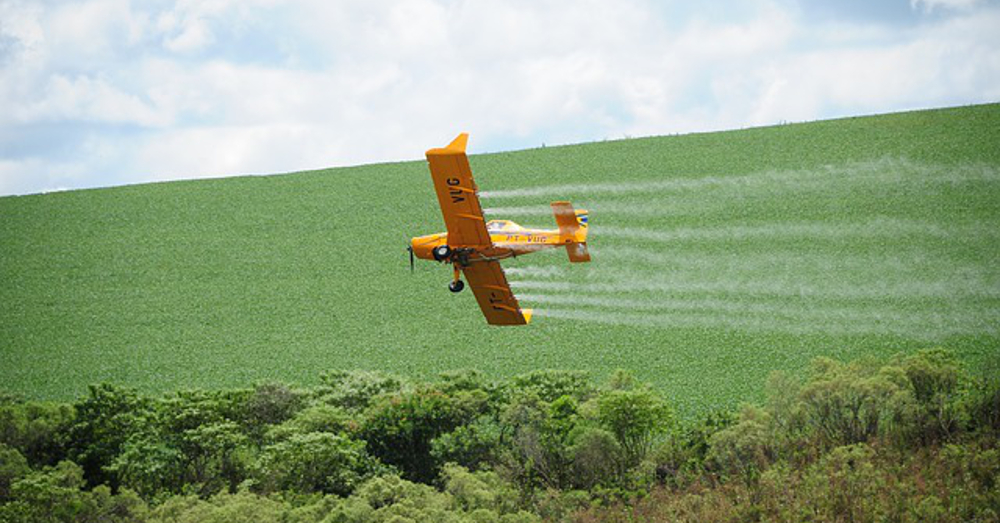
New Dicamba Herbicide Wreaks Havoc Across the US
The rapid emergence of glyphosate-resistant superweeds has led to the development and use of even more toxic herbicides, including dicamba, which has been clearly linked to non-Hodgkins lymphoma. Dicamba is an extremely potent and volatile toxin that is banned during growing season. Monsanto’s new weed killer, XtendiMax with VaporGrip Technology, designed for use with dicamba-resistant seeds, is supposed to be less prone to vaporization and drift.
August 29, 2017 | Source: Mercola.com | by Dr. Joseph Mercola
While the chemical technology industry, led by Monsanto, claimed genetically engineered (GE) glyphosate-resistant crops would reduce the need for herbicides, usage has steadily and significantly risen since the advent of GE seeds. What’s worse, the rapid emergence of chemical-resistant superweeds has led to the development and use of even more toxic herbicides.
This includes 2,4-D and dicamba, both of which have been clearly linked to non-Hodgkins lymphoma,1 a type of blood cancer originating in your lymphatic system. Lymphoma is the No. 1 cancer in the U.K.2 In the U.S., lymphoma accounts for about 4 percent of all cancers, affecting an estimated 72,200 Americans each year.3
Other documented health hazards associated with phenoxy herbicides such as dicamba include developmental and reproductive problems. This is particularly chilling considering the fact that use of these herbicides has risen several-fold since the early 2000s, and their use is now seeing a rapid increase as dicamba-tolerant crops are replacing glyphosate-resistant varieties.
Dicamba has also been implicated in canine malignant lymphoma, raising the risk by as much as 70 percent in some dogs following exposure. Another study4 found that dogs exposed to garden and lawn chemicals such as 2,4-D, dicamba and 4-chloro-2-methylphenoxypropionic acid, have higher incidence of bladder cancer.
Breeds with a genetic predisposition for bladder cancer, including Beagles, certain Terrier breeds and Shetland Sheepdogs are at particularly high risk. The video above, which features a news report from last year, reports on a case where both the family dog and the husband died from lymphoma after using Roundup around their home.
Newer Pesticides Are Getting Increasingly Toxic
The U.S. Environmental Protection Agency (EPA) has also approved more than 100 different pesticide formulations to address growing weed resistance, the synergistic effect of which make them more poisonous.5 Synergy happens when two or more compounds combine to create an effect that is larger than the sum of their parts.
In this case, combining two chemicals increases the toxic effect compared to using each chemical in isolation. These are often called pesticide cocktails. In the past, the EPA has claimed it could not assess the potential synergistic effect of the chemicals without data. However, in late 2015, the EPA discovered synergistic chemical reactions were recorded in patent applications at the U.S. Patent and Trademark Database. Nathan Donley, a scientist with the Center for Biological Diversity, told EcoWatch:6
“It’s alarming to see just how common it’s been for the EPA to ignore how these chemical mixtures might endanger the health of our environment. It’s pretty clear that chemical companies knew about these potential dangers, but the EPA never bothered to demand this information from them or dig a little deeper to find it for themselves.”
Dicamba Wreaks Unprecedented Havoc
Last year (2016), Monsanto released Roundup Ready 2 Xtend soybeans — a stacked trait seed engineered to tolerate both Roundup and dicamba. The problem was, the company had not yet received EPA approval for the herbicide designed to go with these new seeds. As a result, farmers who bought the seed took to illegally spraying old dicamba-based herbicides on their crops. The result was devastating for neighboring farms, where crops and plants withered and died.7,8 As reported by Eco Watch last summer:9
“[S]uch activities caused 10 states to report widespread damage on thousands of acres of non-target crops such as peaches, tomatoes, cantaloupes, watermelons, rice, cotton, peas, peanuts, alfalfa and soybeans. And [in October, 2016], a dicamba drift dispute between Arkansas farmers resulted in one farmer being shot to death.”
Dicamba is an extremely potent toxin and is not permitted to be used during growing season for this very reason. Older dicamba herbicides were only allowed to be used to kill weeds prior to planting. It could not be used on growing crops. Monsanto’s weed killer, XtendiMax with VaporGrip Technology10,11 — which goes along with its Roundup Ready Xtend cotton and soybeans — is made with “chemical technology” said to make the dicamba less prone to vaporization and drift.
Monsanto was sharply criticized for releasing dicamba-resistant seeds before receiving approval for the less drift-prone herbicide, but the company simply blamed the off-target damage on the farmers, taking no responsibility for the catch-22 they’d created.
Now that XtendiMax with VaporGrip herbicide is available, real-world effects suggest the chemical technology supposed to make this herbicide safe to use falls far short of expectations. In fact, the current growing season is turning out to be just as bad for neighbors to those using XtendiMax with VaporGrip as last year, when illegal dicamba formulations were used.
